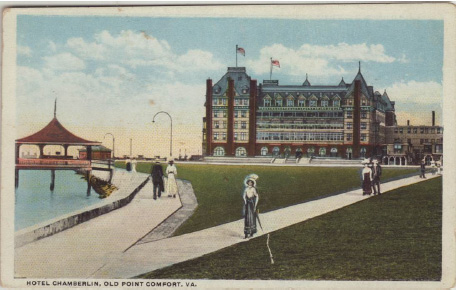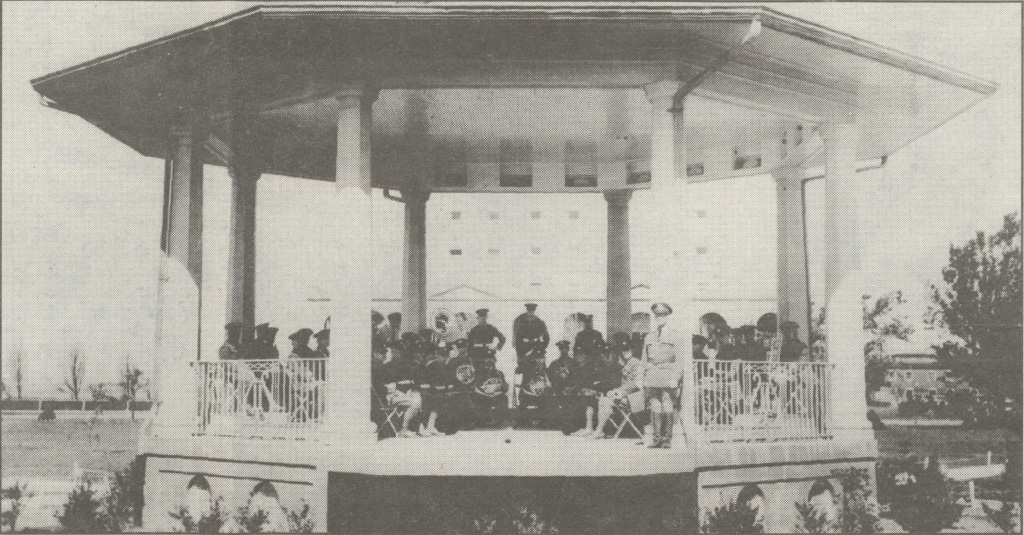
As Fort Monroe begins its new chapter as a National Monument and returns as property of the Commonwealth of Virginia, visitors and locals alike continue to seek out the events, people and memories that have been ingrained into the thick stone walls and picturesque landscape for over 400 years. Every building, stone, walkway and tree has a story to tell. Much of this history has been recorded in books or diaries, or has been passed down orally and some is still waiting to be discovered or rediscovered.
One of the most iconic structures at Fort Monroe is the bandstand located at the center of Continental Park and overlooking Hampton Roads at Old Point Comfort. The bandstand has been the focal point of entertainment and social gatherings at Fort Monroe for 79 years. Its aesthetic value to Continental Park and significance to the Fort is distinctive yet its history is less familiar and begins in 1933 with a determined and energetic Army Captain, Harrington W. Cochran. Captain Cochran was Post Adjutant at Fort Monroe from 1932 to 1936.[1] In the United States Army, the Post Adjutant is responsible for the administrative function of command, including all official correspondence and non-financial records.[2] Under Fort Monroe’s command structure during this time, Brigadier General Joseph Tracy served as Commanding General, Post Commander and Commandant of the Coast Artillery School giving Cochran considerable responsibility and influence.[3] In 1933 two devastating hurricanes, less than a month apart, destroyed many buildings at Fort Monroe including the existing band pavilion at the waterfront.

Cochran used his position to champion the construction of a new band pavilion during the great building projects of 1933 and 1934. During a visit to the Quartermaster General in Washington, DC, he remembered seeing plans for a “small German Bandstand” and requested copies of the plan.[1] He eventually received plans dated June 30, 1924, labeled “Army Medical Bandstand, Washington, DC.” destined to be built at Walter Reed Medical Center. [2] The project had not materialized past the sketch phase due to the high cost of the ornamental ironwork, a copper roof, and custom-built columns. In an effort to ensure construction at Fort Monroe, Cochran redesigned the building plans to reduce the cost of the project and he took advantage of Work Progress Administration (WPA) and Civilian Conservation Corps (CCC) laborers at Fort Monroe who were in the available labor pool.[3] Construction commenced in the winter of 1934, with progress of the work on the “band pavilion” recorded in Captain Cochran’s diary on numerous occasions during the late winter and early spring. From an entry on the morning of March 7th, 1934 Cochran appears rather annoyed when he notes that the band pavilion was being erected with “the columns out of plumb.”[4] Again, on March 23rd, 1934, Cochran writes that “the band pavilion is coming along slowly” and that unfavorable design changes had been made by the Quartermaster Captain.[5] On April 1st, Cochran notes again in his diary that the “railings are going in the band pavilion.”[6] Finally on April 7th, 1934, work on the bandstand was completed and Captain Cochran’s initial diary entry on the 7th reads, “We tried out the Band in the new band pavilion this morning and the acoustics were excellent- much to my relief as I was afraid that lip at the top of the columns which contains the indirect lighting would produce an echo.”[7] The construction of the band pavilion was a success! The inaugural performance at the Fort Monroe Bandstand on April 7, 1934, was given by the 2nd Coast Artillery Band.


The bandstand has required few alterations since its inception in 1934. The structure has weathered many storms despite its vulnerable position only a few hundred feet from the Chesapeake Bay and only several feet above sea level. It sustained heavy damage from Hurricane Isabel in 2003 and required extensive repair, including new columns, the renovation of the front steps and a new electrical and lighting system. The bandstand continues to serve Fort Monroe to this day as a focal point for social gatherings, celebrations and weddings. Locals and visitors appreciate the bandstand for what it has come to represent: history, music, and family…a place to gather together, almost in a spiritual way, like a temple. The foresight of Captain Cochran and his determination and devotion to erecting a bandstand should be remembered and appreciated by all who visit this historical icon of Fort Monroe.
By Robert Kelly
[1] Colonel Harrington W. Cochran, Jr., retired United States Army, to Mrs. McClellan, Fort Monroe, Virginia 20 October, 1974, personal letters of Harrington W. Cochran Jr.
[2] “History of the General’s Adjutant Corps,” last modified November 10, 2011, https://www.hrc.army.mil/site/active/tagd/tagdhome/historypage.htm.
[3] David Johnson, “Continental Park gazebo marks 70th year as post’s main entertainment center,” Casemate, August 27, 2004, 10-11.
[1] Phyllis Sprock, “Building 4,” Inventory of Historic Properties, Department of the Army, July 18, 1979.
[2] Phyllis Sprock, “Building 4,” Inventory of Historic Properties, Department of the Army, July 18, 1979.
[3] Phyllis Sprock, “Building 4,” Inventory of Historic Properties, Department of the Army, July 18, 1979.
[4] Harrington W. Cochran, Diary, “The Adjutant Officer in Charge of Public Work, Fort Monroe,”3/7/1934.
[5] Harrington W. Cochran, Diary, “The Adjutant Officer in Charge of Public Work, Fort Monroe,”3/23/1934.
[6] Harrington W. Cochran, Diary, “The Adjutant Officer in Charge of Public Work, Fort Monroe,”4/1/1934.
[7] Harrington W. Cochran, Diary, “The Adjutant Officer in Charge of Public Work, Fort Monroe,”4/7/1934.





